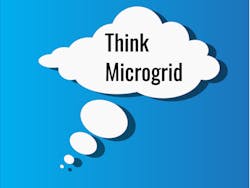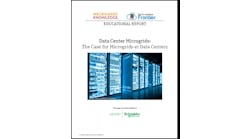Brought to you by Microgrid Knowledge and Think Microgrid, this is the first article in a series that provides a public policy vision for microgrids as a climate solution. It is excerpted from a new Think Microgrid vision paper.
The decisions of policymakers today establish and design the markets of tomorrow. Technology catches up with — and often outpaces — policy, which means that policymakers today bear a great responsibility. They are charged with designing utility markets that are resilient, clean and equitable. This is a daunting task, but they do not have to act in isolation.
Microgrid Knowledge recently launched Think Microgrid to educate policymakers about the unique solution microgrids provide to the pressing challenges of our time. Acting as a unified industry voice, Think Microgrid provides political leaders with the resources they need to understand how microgrid technologies work, what role they can play in achieving policy goals and how regulatory reforms can proactively address barriers that exist today.
We are dedicated to ensuring that communities are positioned to capture the benefits of microgrid technology: resilience, sustainability and cost savings. As outlined in Think Microgrid’s recent vision paper, Microgrids: An Immediate Climate Solution, we work in a spirit of collaboration, combining the real-world experience of companies leading the way to a safer, cleaner and more equitable energy future with practical and pragmatic strategies to modernize policy.
Policymakers and regulators do indeed bear a great responsibility, but they also have great opportunities. Think Microgrid is dedicated to ensuring that they have the support they need to design the future that every community deserves.
Climate disasters demand a new approach
The number and severity of weather-related power outages continues to go up with each passing decade. In fact, the US experienced 70% more power outages from 2010-2019 than in the preceding decade. The effects of climate change are already upon us and are expected to accelerate. Meanwhile, our society’s dependence on electricity grows.
The urgency of the situation demands a new approach — one where policymakers focus not only on reducing emissions but also on preparing for climate disaster.
Make no mistake, it is not the failure of either renewables or large power plants that cause the overwhelming majority of power outages. It is the failure of the wires-based system that delivers the vast majority of the electricity consumed in the US today. In fact, most power outages are caused by failures of the distribution system.
We know there is a solution to this readily foreseeable risk. Microgrids have proven themselves in disaster after disaster, storm after storm. And yet the technology faces a list of headwinds — most centered around outdated regulations — that hinder its wider use. It is time to chart a new course, one that allows our communities to prepare for the climate challenges ahead.
For our leaders, climate change presents three distinct and urgent challenges as they rebuild the nation’s energy infrastructure. Leaders are being called upon to:
- Protect citizens and the economy from energy disruptions already upon us because of climate disasters.
- Redesign the electrical system with the future in mind, introducing cleaner energy technologies to counter even greater weather extremes in the decades to come.
- Make these changes in an equitable fashion, providing distributed clean energy — and the economic prosperity it can bring — to all communities.
Among emerging clean energy technologies, microgrids are unique in their ability to meet these challenges. Along with climate resilience, microgrids also offer additional benefits, including local control of energy, cost management and energy efficiency. This is why a growing number of communities, businesses, institutions, government agencies, utilities and military installations across the United States are building microgrids. Unfortunately, too often, they are installed after disastrous power outages. Had they been built beforehand, hardship could have been avoided.
So what can be done to speed the development of microgrids? And what is causing the delay?
Policy needs to catch up
We are witnessing a classic example of technology outpacing policy. Too often those seeking to install microgrids face delays and extra costs because of rules and regulations designed for an electric grid of the last century. These outdated rules make it difficult, and at times impossible, to fully capture the opportunities offered by software-based energy systems such as microgrids.
Microgrids do not benefit from the same kind of policy attention and innovation enjoyed by solar, wind and other forms of climate-friendly energy. This is largely a problem of familiarity; while simple microgrids have been around since the days of Thomas Edison, today’s advanced microgrids — fast, intelligent and clean — are newer to the scene than solar and wind energy. Yet, these microgrids dramatically extend the benefits of renewable energy, adding resilience and energy reliability.
While there are good examples of incremental actions in some states, it is clear that regulators and policymakers have not yet seized the opportunity to put forward the kind of innovative policy mechanisms that can foster microgrids.
Greater education about microgrids is clearly needed. In polls taken in 2020 and again in 2021, the Civil Society Institute found voters lacked knowledge about microgrids. Once the concept was explained, both Democrats and Republicans expressed strong support for the technology. (See video discussion here.)
Microgrids: An immediate climate solution
In the coming weeks, we will provide additional detail on the public policy vision for microgrids put forward by Think Microgrid. Look for these upcoming articles:
- A Grid Not Prepared for the 21st Century.
- Microgrids for a 21st Century Grid.
- How to Capture the Full Benefits of Microgrids in Climate Change Strategies and Infrastructure Plans.
Read the full vision paper, courtesy of Think Microgrid, to learn more. If you feel that microgrids need a unified voice in regulatory and policy discussion, please join Think Microgrid. Learn more about becoming a member of Think Microgrid, an affiliate of Microgrid Knowledge.








